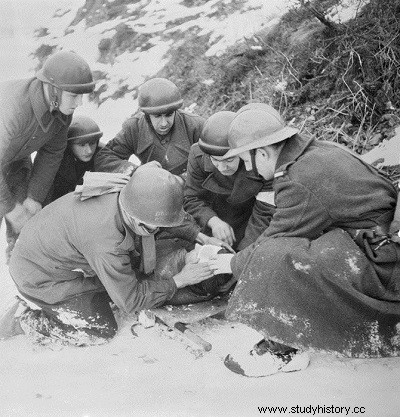
The day of October 4, the first day of battle, is disappointing. On my right, the attack of the 1st D.B. against Le Thillot was based on the combination of three actions leading to the encirclement of the locality:
• Lieutenant-Colonel Faure's paratroopers were to engage , to the right of the Americans, on the crest of Longegoutte, in the part which bears the name of Gehan forest, then turn north towards Le Thillot;
• The south of the locality was to be approached by the Durosoy sub-group, coming from Château-Lambert;
• The east, finally, was to be reached by the C.C.3., having as initial objectives the Servance balloon and Fresse-sur-Moselle.
Triggered at 6:30 am, this operation ended in complete failure. Nothing can overcome the German defenses of Château-Lambert and Servance. Thus, the offensive action of the 3rd D.I.A. fired without first having ensured the protection of its southern flank. 'on their left the vanguards of the 3rd D.I.A. climbed towards the Longegoutte ridge with the illusion of still finding the Americans there.
I had divided my division into three tactical groups:
I) at right, in the eastern part of the Longegoutte forest, General Duval's G.T. I, including the 3rd R.T.A., the 3rd G.T.M. and an artillery group;
2) on the left, in the western part of the Longegoutte forest, the G.T. 2 under the orders of Colonel Chappuis, assisted by Colonel Hogard and the state- major of goums. This G.T. included the 7e R.T.A., the 2e G.T.M. and an artillery group; 3) the 4th R.T.T., the 3rd R.S.A. and the 7th R.C.A., which I kept in reserve.
On October 4, at daybreak, the first elements of the 3rd and 7th R.T.A., landed at night with the greatest discretion, went to the points planned to relieve the two battalions of the American 7th Infantry Regiment supposed to hold the forest of Longegoutte. But to our great surprise these battalions had been withdrawn during the previous nights to Remiremont, without our having been informed. The violent machine-gun and mortar fire which greeted our first units halfway up the slope left us in no doubt. The enemy is occupying our starting base in force. We will have to conquer it at the cost of a preliminary battle in which the division will be engaged almost entirely. Noting the failure of the 1st D.B., as well as the anticipated and forced engagement of the 3rd D.I.A., General de Monsabert ordered General du Vigier to limit himself to covering the action of the paratroopers. He instructs me to establish my group on the northern edges of the forest of Longegoutte to prepare myself to cross, on October 6, the course of the Moselotte. But all along my forehead is a fierce, breathless, merciless struggle that irresistibly evokes the glorious but tragic memory of the dark Vosges battles in the winter of 1914-1915. My direct opponent is a general with a French name, L'Homme de Courbières, commanding the 338th Infantry Division. An energetic and resolute leader, he was able to bring together various units, supported by battalions of heavy machine guns and making the best use of the defensive possibilities offered by the forests and the relief of the terrain. On October 5, after conquering the southern slopes of Longegoutte in hand-to-hand combat, our units approached the ridge but, the next day, L'Homme de Courbières resorted to a tactic to which we will see him remain faithful:he launched squarely its whole division to the counter-attack.
In the western part of the forest, the Chappuis group blocks the German grenadiers. But, to the east, they sink between the Col de Morbieux and the Col du Rhamné, cutting our device in two and isolating our advanced elements, the first parachute regiment and the 2nd battalion of the 3rd R.T.A. For thirty-six hours the two adversaries, who mutually threaten each other with encirclement, confront each other in confused and violent combat under the woods. In the end, the situation was restored to our advantage:on the evening of October 8, my group crowned the whole of the Longegoutte ridge. He conquered... his starting base.
But he only achieved this success after four days of battle and by committing almost all of his forces. I had to call the 4th R.T.T. to cover the rear of the two battle groups since, behind them, Le Thillot was still holding out. In addition, it was necessary to form a tactical group No. 4 (G.T. 4) entrusted to Colonel Bonjour and made up of the 3rd R.S.A., the 2nd dragoons and the Pator battalion, the F.F.I. of Franche-Comté, in order to maintain liaison with the Americans. By small forest paths, this group reached the western approaches to Thiéfosse; the threat it poses to the Moselotte will ensure the security of the northern flank of the attack which will now be launched in an attempt to cross the river upstream.
This attack begins on the 9th October with terrible weather. Rain, fog and snow alternate or combine. We're moving forward in the water.
But we're still moving forward. On the left of the sector, Colonel Bonjour crosses the Moselotte towards Pubas and pushes on to Trougement on the G.C. 34 which leads towards Bresse. In the center, the Tunisians of Guille
baud, the Algerians and goumiers of Chappuis also force the river between Thiéfosse and Saulxures. On the right, the 3rd R.T.A. of Colonel Agostini stubbornly clears a passage in liaison with Faure's paratroopers, towards the exit of the forest of Gehan, where the enemy, crouched in almost invisible log shelters, resists with frenzy.
October 10, a very clear hope arises on our left. At noon Colonel Demetz's 2nd dragoons exceeded the village of Planois by 2 kilometers. Will it be possible to rush to La Bresse and bring down all of a sudden by this lateral movement the whole chain of heights which, to the north and north-east of Saulxures commands this communications node?
